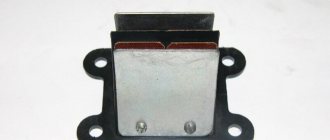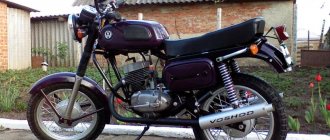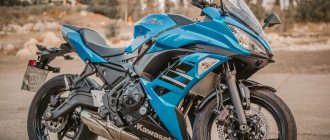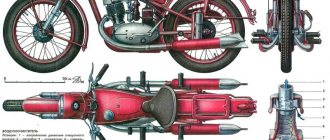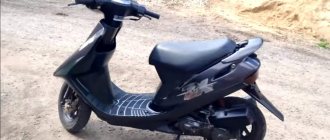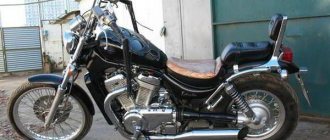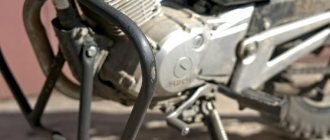There are many legendary motorcycles. The Americans will call you Harley-Davidson, the British - Royal Enfield, the Italians - Moto Guzzy... In the territory of the former post-Soviet space, which includes the countries of Eastern Europe, such a motorcycle is, of course, the Java 350.
Today, when you go to the company’s website, you can find modifications adapted to modern requirements, like the Jawa 350 Replica or Jawa 350 Premier. The legendary brand continues to be popular. But to understand the reasons for this popularity, you should turn to its origins and get to know Java better.
Bright, stylish, but still Dnepr
Looking at this motorcycle, different emotions immediately appear in me. On the one hand, the author of the project had a hand and spent a lot of time creating this “horse”, but on the other hand, I don’t see much point in them. It is unlikely that this homemade seat will be more comfortable than the standard one.
Exhaust
- the highlight of the whole design. As for me, the “cans” are too massive for the pipes that go directly to the cylinders. I think if they were made thicker in cross-section, this modification would look somewhat more impressive.
The colors here are extremely bright and dull
, but this is
a matter of taste
. And, according to the classics of the genre, we are witnessing the abandonment of the steering wheel and the fact that the author of the project gave preference to clip-ons, completely cutting down the ability to move around on this motorcycle.
FAQ
- Do the spare parts for 634 and 638 fit together? For the most part, yes. But parts for a more recent model, that is, 638, are more often found on sale.
- How many horses are there in Java 350? Exactly 26 fast horses. True, no one remembers exactly how the Czechoslovak plant measured power, at the crankshaft or at the rear wheel.
- I have an old anniversary car in my garage, I got it from my grandfather, it hasn’t started for about twenty years, but it looks decent. Does it make sense to invest in restoration for the purpose of selling? Yes, if the bike is in overall good condition. Collectible pieces can be quite expensive.
- What is the lifespan of this motor? There is no exact data, but there are reviews from owners who claim that the engine runs 30,000 km or more without repairs.
- How much does the Java 350 motorcycle weigh? Curb weight with all fluids and other things is about 185 kg, dry weight is about 156 kg.
Java engine tuning
First of all, I would like to talk about modernizing the engine of this once legendary bike.
The latter is done quite easily and quickly these days. The method of strengthening the power unit, given to us by our parents, will remain virtually unchanged. These motorcycles are quite easy to boost. Tuning Java often involves adding another carburetor to the engine. In this case, the mounting of the basic fuel regulator is subject to change. A carburetor is installed on each cylinder only after a new mount (adapter) is installed on each “pot”. All this is mounted on pins - there is no need to invent anything new, as you can see for yourself. Each carburetor needs a separate filter. Buying a faucet for a tank with a couple of outlets is also not difficult.
Firstly, you need to adjust the purge channels for tuning the Java 350. In addition, the main goal of upgrading the Java engine is to increase the compression ratio. This way you can certainly supplement the power of the bike. All this won't cost that much. If you do not have the necessary tools and equipment for speeding up, you can turn to a turner. Even in small towns, such specialists are present, for which we must thank, first of all, the Soviet government, which relied on the engineering and mechanical potential of the labor resources of the USSR. There are many machines left on post-Soviet soil that are quite suitable for reducing the combustion chamber.
Do not forget that any changes to the combustion chamber, as well as the cylinder windows, must be carried out with the utmost care. Any mistake, in this case, can render the rather fragile duralumin “pots” unusable once and for all.
You will probably find photos of bikes after some of the above modifications here too.
New standards
In 1984, a new modification, type 638, went into production. Changes affected the power unit. The profile and flow area of the intake and exhaust channels were changed, improving the purging of the cylinders. The Java 350 engine received an aluminum cylinder block and lightweight pistons. Power increased to 27 hp. s., and fuel consumption decreased to 4.2 liters. The maximum speed remained unchanged.
An important innovation was the installation of electrical equipment operating at a voltage of 12 volts. The new 12-volt system has significantly reduced the weight of the generator and other electrical components. The measures taken led to a weight reduction to 149 kg. It is based on this model that the Jawa 350 Replica is being produced today.
During production, the design on these Javascripts was adjusted several times. The shape and finish of the fuel tank changed. A small fairing was installed on the steering wheel. No matter what changes the Java 350 underwent, the technical characteristics were at a high level.
General concepts of Java tuning
Improving Czechoslovakian Jawa quite often involves the installation of new electronics.
In addition to the ignition system, the number of lighting devices also changes. Fog lights are installed, new indicator lights are installed on the panel, the sound signal is replaced, etc. However, the instrument panel is often left unchanged by tuning specialists for the 634 Java. This legendary Czech motorcycle already has everything that is needed to indicate the operation of the bike. The most pleasing thing is the presence of a tachometer. Sometimes the front end of the above iron horse becomes heavier. Since a motorcycle can easily rear up (on a goat), this often infuriates many motorcycle enthusiasts. Tuning Java, in this case, makes the front structural elements heavier in any way the owner likes.
Sports modification
The operational parameters of the Czech motorcycle are still relevant today, but the design leaves much to be desired. How to carry out sports tuning? “Java” in this matter is most easily upgraded by installing parts from Kawasaki or Yamaha racing bikes. The fenders will fit from the first model, and the second option is a good donor for brakes, front forks, shock absorbers, pendulum and wheels.
The pendulum element for installation in the socket of the motorcycle in question should be narrowed by replacing the standard bearings with needle pin elements from the Volga. The changes made give the vehicle better controllability, stability and maneuverability. The body kit can be done independently or in a specialized workshop. When doing work at home, you need to be careful and stock up on fiberglass or plastic.
What can be tuned in Dnepr?
At the time these motorcycles were released, their quality was at the highest level, so all the components and the design itself still actively serve all owners. But modern requirements for appearance and some technical characteristics force us to carry out cosmetic and internal modifications to the motorcycle. Of course, you can do the tuning of the Dnieper with your own hands, but if you don’t have enough knowledge, workshops are open in most cities where people are probably knowledgeable in modernizing Soviet motorcycles.
There are basic elements that need to be changed when tuning, and in this model the following elements can be improved or even replaced:
You can also briefly discuss the refinement of each element. For example, to tune the exhaust system, you will need to install a forward flow system and nickel elbows, which you can do yourself. External tuning will contain a lot of chrome parts, so tuning the Dnepr engine will involve a polishing process. If you upgrade these two parts, your motorcycle will not only look great, but it will also sound great.
As for technical modernization, the above recommendations can be supplemented by installing a fifth gear on the Dnepr. It is unlikely that you will be able to do this kind of work yourself, so it is better to turn to specialists with experience. But the result will be justified; your vehicle will have reverse gear. But even this is not where the basic tuning ends, because some Dnepr models, depending on the year of manufacture, can be improved by installing an electric starter.
In conclusion
To improve the performance of their two-wheeled “iron horse” and give it a second life, many owners use tuning. “Java 350” is a quite decent motorcycle, but in design and parameters it no longer reaches modern models. Modernization allows you to make fundamental changes to the design, resulting in a car whose owner will be the envy of everyone around you.
It is quite possible to remake the equipment yourself. Properly performed restyling will not only transform the motorcycle, but also make it a unique bike. The main thing is to stock up on the necessary materials, theoretical knowledge and patience.
Body and frame tuning
Its appearance will largely depend on how the frame base on the motorcycle is redone. At the present stage, there are several popular ways to remake the Dnepr frame.
Regardless of the modification of this bike, all models have a similar frame design.
You can extend the frame at the rear of the motorcycle. This tuning involves adding 15-20 centimeters to the frame, which increases the space for the rider’s legs. When the frame is lengthened, the driveshaft also lengthens, and the adjustment of the distance by which the frame should be lengthened depends on the height of the driver. If you lengthen the frame in the front part, you can achieve a landing similar to classic American choppers, while you do not need to change the driveshaft, but you will have to redo the pedal arrangement.
The frame is also expanded. We are talking about installing a more powerful rear wheel. To do this, an additional gearbox is installed on the cardan shaft, which will shift the cardan output to the side. It is best to install wheels with a profile of 130-150 millimeters, this way you can achieve optimal ride quality from the bike. A tire that is too wide can add certain difficulties to the driver.
When changing the angle of the front fork, experts recommend increasing the angle of inclination by no more than 35 degrees, otherwise the handling of the motorcycle will be seriously affected. In addition, an increase in the angle of inclination is accompanied by loads on the “stays” of the front fork, which leads to their rapid wear and failure.
Changing the angle of the rear shock absorbers will provide a more aesthetically pleasing appearance for the motorcycle, however, as with the front forks, too much angle can result in a loss of load-carrying capacity to the point where even single-passenger riding becomes impossible.
First steps to success
The first motorcycle from which the history of the famous JAWA plant began was presented at the Prague Motor Show in 1929. It was a JAWA 500cc OHV model with a teardrop tank, based on the German Wanderer model. The Java motorcycle was equipped with a single-cylinder 498.7 cc engine with a power of 18 hp, mounted in a double stamped frame. This motorcycle, which accelerated to 95 km/h, even then acquired the characteristic JAWA coloring - red with yellow accents. Subsequent series of this model were devoid of the shortcomings of their predecessor: in particular, a new muffler, an adjustable parabolic mirror appeared, and the front fork began to be assembled from a pressed sheet. However, it was quite an expensive motorcycle for that time, so there was a need to create a new model.
The next model, developed by the English designer George William Patchett, was the JAWA 175cc Villiers motorcycle. It was presented at the Prague Motor Show in 1932 and began to be positioned on the market as “the best motorcycle for little money.” It was a model with a three-channel two-stroke engine with a volume of 172.6 cc and a power of 5.5 hp, which weighed 70 kg and accelerated to 70-80 km/h. In the first year, three times as many JAWA 175cc Villiers were produced as the 500cc Java, as this model became in great demand due to its lightness, compact size and more affordable price. In subsequent years, the motorcycle acquired a saddle-shaped fuel tank, two long mufflers and other structural elements.
The 30s were marked by the release of other Java models - JAWA 250 Special, JAWA 350 OHV, JAWA 100 Robot and JAWA 250 Duplex. JAWA 250 Special was released in 1935, and at that time this model became one of the main products of the plant. The JAWA 250 Special had a 248 cc two-stroke single cylinder engine. cm with a power of 9 hp, the model weighed 95 kg and reached a maximum speed of 100 km/h. Subsequently, the motorcycle was equipped with an Amal carburetor, a new gas tank and muffler. Another motorcycle, the JAWA 350 OHV, released the same year, was intended for sports competitions. It was a model with a 15 hp engine, it weighed 142 kg and accelerated to 115 km/h. The motorcycle was produced not only in a standard version, but also in an improved version, which had more chrome parts, a larger headlight and foot-operated gear shift.
One of the most popular models of the late 30s was the JAWA 100 Robot motorcycle, designed primarily for young people. The CZ plant also produced similar models, and they were considered the best in the small motorcycle segment. JAWA specialists also decided to strengthen their position and developed the JAWA 100 Robot motorcycle, introduced in 1937. It was a model with a 98.8 cc single cylinder engine. cm with a power of 2.6 hp, which was started using pedals from a standstill or from acceleration. JAWA 100 Robot weighed only 49 kg, reached a maximum speed of 65 km/h, and it really turned out to be very popular among young people and light motorcycle enthusiasts. Before the outbreak of World War II, the plant managed to release another new product: JAWA 250 Duplex with a 246 cc engine and 9 hp. The model had a maximum speed of 100 km/h and weighed 115 kg.
Unusual yellow Java 638
Perhaps, such Java is truly the only one in the world!
Here I can definitely say that I would like this “tuning”
did not engage in training under any circumstances. I had enough sad experiences with vinyl film, but this is still on a completely different level.
I can’t say that this solution looks beautiful, nor can I imagine what will happen to all these “carpets” after a trip in the rain.
Extraordinary JAWA tuning in action!
I remember as a child I was perplexed when I saw motorcycles passing by, whose seats were covered with some kind of skin, carpet, fur coat or something like that. Is this really convenient?
What's wrong with standard casing? Even if it was in short supply, is it really impossible to use another, more suitable material?
Well, I’m generally silent about the fairing. The solution with lighting devices is strange, in my opinion. At the very least, very extraordinary. And yet it is not clear why he was wrapped in a rag. Probably to match the seat.
Walking abilities
There's nothing but good things to say here. Java confidently holds the track, the dirt is a little worse, but since she is a thoroughbred “road racer”, there is no point in getting into the mud with her.
Java copes well with long journeys; the long engine life allows you to travel many thousands of kilometers without breakdowns. And the “Southern” trunk allows you to take a decent amount of things, which is rare even for most modern motorcycles (without additional body kit).
In the city it feels as good as on the highway, the center of gravity of the motorcycle is high, because of this it handles well at low and medium speeds.
For driving on the highway, of course, you should come up with some kind of windshield, but I think this will not be a problem.
The motorcycle's consumption is low, about 4.5 l/100 km, a pretty good indicator
Improved technical characteristics
The following steps are allowed:
replacing standard crank (crankshaft) bearings with support units of better quality, attention, without reducing the size of the journals; installation of K-301B instead of the base carburetor, with mandatory adjustment of the synchronization of its operation; cleaning the engine cylinder channels and setting the ignition timing from 40 to 42 0; installation of a pair of air filters from GAZ-24 or Moskvich-412; minimizing the weight of connecting rods and pistons - an example is removing flash - to improve engine performance; organization of inertial boost - with it, the tuned Ural will be able to reach higher speeds, but only if a high-quality and reliable compressor is selected; production of a camshaft with cams of a non-standard profile, facilitating changes in valve timing; although it is better to entrust this task to professionals; making new gearbox gears is a more than justified measure, since standard parts usually make quite a lot of noise during operation, shift relatively poorly and do not last very long; alignment, grinding, lapping of both intake and exhaust valves - to increase the efficiency of filling the cylinders with fuel.
Release of improved
During this time, development did not stand idle in vain, but newer and improved motorcycle models were produced. The next achievement was the Java-350, which was equipped with a two-cylinder two-stroke engine. This model, like the previous Java-250, was taken as a basis and constantly improved without affecting the foundations of their system.
These models, and their various configurations, served motorcyclists staunchly. By 1960, every third Soviet resident owned Czechoslovak Java, which is about forty thousand people. But the real rush to buy Java began a few years later. In 1976, which was engaged in the supply of motorcycles from Czechoslovakia to the Soviet Union, made a unique number of deliveries of bikes equal to one million Yavs. According to statistics, more than one hundred thousand copies were bought per year. A huge number of people lived with the dream of buying this Czechoslovak miracle, which at that time cost unrealistic money - 650 rubles. You could also add a Velorex stroller to the kit for 150 rubles, and as a result you would be able to ride a motorcycle with the whole family. Equipment from a domestic manufacturer, for example Kovrovets, was absolutely not popular, despite the fact that the price was 3 times cheaper. Real motorcyclists saved on absolutely everything, trying to save up for the treasured Java. At that time, Java was akin to a modern Harley. This particular model of motorcycle was ridden by a cartoon wolf from the cartoon “Well, wait a minute!” It was possible to paste over the gas tank with various pictures of curvaceous blondes and photos of a Java motorcycle. They were brought by corporals who had served in the GDR. They were a kind of bridge between foreign countries of mystical socialism and the real Russian hinterland. There was only one unspoken rule - do not put pictures of cars, even imported foreign cars, on the bike.
New Java – 350
In 1974, a small revolution took place, and an improved jawa motorcycle was released. The difference between the new Java-350 of the 634-01 variety was that it could drive on roads of any quality, and not just on more or less smooth ones. She was not afraid of any pits or off-road conditions. This was ensured by an updated chassis, the basis of which was taken from sports models that were intended for six-day motorcycle racing
Close attention was paid to the bike's stability when cornering and when riding on slippery roads and ice. It is not surprising that the new model has gained even greater resonance than its predecessors.
Technical specifications
The main technical characteristics of the updated Java of that time:
The weight of the bike was only 155 kg, it was much lighter than the Soviet ones
This characteristic was important, because many happy Java owners did not live on the first floor, and the weight during transportation to the desired location was important
The load capacity of the Java is 180 kg, although this figure is very arbitrary, since everything was not transported on the trunk of this motorcycle.
The two-phase, two-cylinder air-cooled engine is another undeniable advantage of this motorcycle.
The rated speed that can be obtained from this motorcycle was 130 km/h.
The power of this unit is 22 horsepower. Without load, the climb that can be overcome is 72%.
With a tank volume of 16.2 liters, fuel consumption is only 4 liters per 100 kilometers.
Such characteristics allow the motorcycle to travel on the highway at a speed of 80 km/h without refueling for approximately 400 km. Java should be fueled with A-76 or A-80 fuel. The generator is 6 volts and 75 watts, the battery capacity is 14 ampere-hours.
Advantages and disadvantages
The motorcycle had excellent driving characteristics, and apart from the hard seat, it was ideal for traveling with two. Fast and comfortable, stable and big. The dashboard has only everything you need - an accurate speedometer, turn signal, tachometer, generator indicator, high beam and neutral. If you look for Java defects, you can only highlight low motor power and not a very high rated speed.
After the division of Czechoslovakia, the branch in Bystrica launches the production of a new model - the Java 250\593Master. The developers installed a two-stroke liquid-cooled engine in it. Since 1995, the plant has launched the production of new Java motorcycles (Mosquito), which have a low-power engine (50 cc), which was produced in Slovakia by Tomos. The company produced equipment commissioned by foreign companies, for example, from Argentina. They also produced a dual-purpose motorcycle 350/640, which was made in the spirit of enduro.
Addition
Tuning Java 350 very often affects the exhaust system. Despite contraindications from specialists, many owners install forward flow systems made from VAZ 2131 mufflers on this motorcycle; 21213; 21214. The part of the pipe leading to the engine is cut 5 cm from the muffler itself, and the part going out is bent at the required angle. When connecting to the elbow, the pipe is slightly cut and pressed tightly. The body mount is first welded to the forward flow, and a footrest is finally mounted on the motorcycle itself.
The tachometer, often borrowed from the VAZ 2106, will add to the presentation and functionality of the unit. Its connection is made according to the same parameters as in the car. Installing a starter on a Java 350 is a rather complicated procedure, but quite realistic. It requires a flywheel change, additional mounting on the body and a reinforced battery.
Motorcycle lighting is another characteristic manifestation of sports tuning. LEDs, the color of which can either emphasize the color of the device or be in contrast with it, illuminate key design components: the engine, exhaust pipe, rims.
Correctly performed tuning can not only transform your two-wheeled friend, but also significantly improve its technical parameters, making the motorcycle the envy of surrounding motorcyclists.
Advantages
Many motorcyclists attribute the excessively light front part to the main disadvantages of the Java. In this regard, to achieve a general reduction in weight, a counterweight is installed at the front. Installation of disc brakes, alloy wheels, and a more wear-resistant chain is also sports tuning. At the same time, the Java 350 acquires characteristics characteristic of motocross motorcycles, namely:
- increase in speed indicator;
- fast acceleration;
- improved handling;
- safety;
- beautiful exterior and convenience.
Sports restyling is the most common type of modernization in relation to a Czech motorcycle, which is due to its technical features.
Improved appearance and safety
Think about safety first. Standard rims, and even more so drum brakes, are not able to cope with the increased power. It is recommended to install a good disc brake along with replacing spoked rims with alloy wheels. This will not only give a modern look to your bike, but will also significantly improve stability on the track. Accordingly, improved rims from another motorcycle are designed for greater braking force and have normal mounting for the brake disc. Good road tires are also a must.
Replacing headlights and other outdated lighting equipment will appeal to everyone. And the dashboard can be easily transformed by installing LED strip lighting.
The standard steering wheel can be easily replaced with clip-ons or a straight-shaped steering wheel, which will somewhat improve the driver’s aerodynamics due to the inclined seating position. Installing wind deflectors is no longer in fashion, as in Soviet times; they create too much air resistance in front of them. Much preferable is a sports body kit, which, depending on the financial investment, can be picked up from any other motorcycle, but if you really want to make it yourself from fiberglass and epoxy resin. Tuning a Java motorcycle in the photo:
And finally, we want to say that a forced engine requires good 2-stroke oil and timely maintenance. Java tuning is a fascinating activity that requires imagination and direct hands. If you follow the tuning technology, the result will not leave you indifferent
Java is a dream motorcycle of the 70-80s of the last century. IZH, Voskhod, Minsk, even the powerful Ural, all this is not the same in comparison with the only imported motorcycle widely available to the Soviet motorist - Java. And even though this is not a bike from the decaying, but technically more developed West, but an import from a country party to the Eastern Treaty, Czechoslovakia, at that time, was ahead of the USSR in the quality and technical perfection of the motorcycles produced. Java was perhaps the best thing that a Soviet person could acquire for himself back then, and the motorcycle deservedly became a real legend for several generations.
1970 The Java 350 model is entering the market. A powerful, maneuverable motorcycle with a load capacity of 200 kg, a two-stroke engine, disc brakes, and a fashionable and sporty appearance. Java is completely different from other models available on the market. Soviet motorcycles of that time were not far removed in their technical characteristics and appearance from the German models of the 40s, on the basis of which mass production of domestic motorcycles was launched using equipment exported from Germany. Owning a Java motorcycle was considered prestigious, fashionable, and simply a must for anyone who wanted to keep up with the times.
Rare and beautiful
One should not think that Czech motorcycles were sold exclusively in Eastern Europe. Jawa products were also supplied to the West. In 1969, an export modification of the Jawa 350 Californian IV typ 362, 363 was developed, which featured an original design. But relatively few such machines were produced.
A little later, in 1970, they released a modification of the Jawa 350 U? typ 633/1 Bizon, the characteristic features of which were a specifically shaped fuel tank and an abundance of compartments for storing tools and luggage. Today such a bike is a rarity, and if you happen to have a similar model at your disposal, then, unlike some Izh Planet-5, its tuning will be simply madness.
Features of electrical equipment
In many respects, the components and assemblies of the Czech motorcycle were similar to domestic products, but at the same time they differed:
In those years, Java motorcycles were in short supply, so they were often sold second-hand. And at the same time, the price remained quite high. New owners could immediately get behind the wheel and operate the equipment without any restrictions, because:
Repair instructions for Java motorcycles officially supplied to the USSR
However, the manufacturer constantly modernized its motorcycle models, and each time made changes to components and assemblies. In particular, in different years the following were supplied to the territory of the USSR:
Original wiring diagram for Java 12V model 638
Equipment 6W
For the first 8 years of deliveries from Czechoslovakia, JAWA motorcycles were equipped with equipment designed for a current of 6V.
Original color diagram of electrical equipment Java model 634
There are differences in the above diagram due to modification. In particular, the JAWA 634.8.00 model does not have:
Subsequent motorcycles had these electrical parts installed at the factory. And domestic craftsmen independently equipped their “iron horses” using a new scheme.
Differences in voltage were not an obstacle for owners, who often independently converted the motorcycle’s power supply from 6V to 12V. This required:
Equipment 12W
Later, the manufacturer recognized the promise of 12-volt equipment and began to equip its products with it. Thereby:
Original photo of the Model 640 wiring diagram in Czech
Features of 12 volt equipment include a bipolar turn relay, which has not previously been found on motorcycles. Its operation scheme is based on the principle of the difference in the current consumption of the control lamp (6W) and the direction indicator lamps (21W):
when turning on the right turn, “+” from the generator or battery enters the right turn circuit, passing through the terminals of the bipolar relay;
Java in the 21st century: is it easy to own a legend?
Greetings, friends!
Many people remember JAWA motorcycles from Soviet times as a very reliable, trouble-free motorcycle with excellent driving characteristics.
But is this true today?
Java 638-5-00, 1985
Java 638-5-00, 1985
After all, over more than 30 years, a lot has changed dramatically both on the roads and in our lives in general.
Well, using the example of my Java specifically, I will try to tell you what Yavists have to face in our time.
What else can be improved?
Some owners improve the exhaust system of the Java motorcycle. Tuning, the photo of which is presented below, is performed by installing direct flows from the mufflers of VAZ cars. The pipe leading to the engine is cut fifty millimeters from the muffler itself, and the outer part is bent at a certain angle. To connect to the elbow, the pipe is cut and installed securely. First, body clamps are welded into the forward flow, and a kickstand is installed on the bike.
The tachometer taken from the VAZ-2106 adds additional aggressiveness and presentability to the two-wheeled unit. It is connected identically to the connection diagram in the car. To install a new starter on a Java, you will need to replace the flywheel, install an additional housing mount and a reinforced battery.
A good innovation would be to change the lighting of the motorcycle. You can choose LEDs to match the color of the unit or play with contrast. The lighting of the rims, exhaust pipe, engine and other main components of the device will look original.
There are no boundaries for perfection
In 1964, after modernization, the Java 350 received a new designation - K?va?ka Automatic typ 360/01. The main characteristics, such as power and maximum speed, remained at the same level.
But changing gears has become much more convenient due to the installation of a semi-automatic clutch. The design of the optical elements has been changed. The shape of the wings was adjusted. The popularity of the Java 350 grew and, despite the fairly high cost of the equipment, queues lined up in stores for it.
This model can already be safely called a cult model. Tuning it is not the best solution. Many motorcycle history buffs want to add Java 350 354/06 and 360/01 motorcycles to their collection of rarities.
Exhaust system improvement
Another significant thing in tuning the Java 350 is the exhaust system. Unlike a 4-stroke engine, in a 2-stroke engine the cylinder is filled by purging the cylinder. With a properly assembled resonator, a fresh fuel mixture effectively fills the cylinder, and due to the conicity of the resonator, the sound wave is reflected. Thus, part of the mixture does not fly out into the pipe, but returning to the cylinder gives up to 20% more power. You can weld such a resonator with your own hands from sheet steel 0.6-0.8 mm thick, and argon or semi-automatic welding is recommended. The exhaust pipe of the resonator can be made by shortening the standard one by increasing the cone according to the drawing:
According to the figure, the engine will have a sharp pickup and increase in power around 5000 rpm. The damping nozzle is not necessary and only performs a noise-absorbing function. As with tuning the Voskhod motorcycle, this resonator can be used in the same way.
The significant mass of the crankshaft has high inertia, which is done for smooth operation of the engine. By lightening it, you can achieve a sharp response to gas and improved acceleration dynamics. Keep in mind that with this modification of the engine, it is extremely reluctant to operate at idle and low speeds. And of course, don’t forget about replacing the ignition from a contact system to an electronic microprocessor system.
Read more: Tuning Solaris 2022 photo
Decent characteristics of Java 350
The bike, unlike its predecessors, received a two-stroke two-cylinder engine with a volume of 350 cc. cm, air-cooled. Power increased to 16 hp. s., and in later versions, after installing a new carburetor, up to 18 liters. With.
By the way, the Java 350 carburetor was subsequently modified several times. The maximum speed was 115 km/h (with a direct landing of the motorcyclist). The drum brakes worked reliably, and the front and rear forks with telescopic shock absorbers ensured comfortable movement on paved roads.
This became especially noticeable in 1958, when cone-type shock absorbers were replaced with piston ones. The voltage of the battery and generator used to operate the electrical equipment of the Java 350 motorcycle is 6 volts. Weight – 139 kg. Consumption, for that time, was very moderate - 3.6 liters.
The appearance of the model not only corresponded to the trends of the time, but was progressive and well thought out. It was the modification 354/06 that Viktor Tsoi was seated on by the author of the monument to the famous rock musician, Alexey Blagovestnov. As an element of a monumental composition, old Java looks very harmonious.
Java tuning and modification of various parts of the motorcycle
Java motorcycle tuning with your own hands. What can be improved in the Java model. Increasing power and other characteristics of the motorcycle.
The legendary Java 350 motorcycle is the dream of every motorcyclist of the late 20th century. Not a single Soviet motorcycle could compare with the quality of workmanship and smooth running of the Java. The particular popularity of Czechoslovakian technology is still relevant today. Naturally, every owner wants to improve the characteristics of the model, and the topic of today's article is Java tuning. In it we will look at what Java 638 tuning is, how to achieve better performance from the engine and create a modern appearance with your own hands. Let's find out how the Java 634 tuning differs from the 638 model and which is better.
Tuning Java 350 let's start with the engine. Clean the engine thoroughly from dust and oil to prevent dirt from getting into the engine. Having completely disassembled the engine, carry out a complete inspection for wear. It is recommended to immediately replace the bearings with new Japanese ones, since only they can cope with the increased speed and increased power when tuning the engine. Keep in mind that boosting the motor is a serious matter; at least turning, a grinding tool, and preferably a drill to change the purge channels will be required. The factory shape of the channels provides traction at low and medium speeds, which is done in order to save fuel. By slightly boring the cylinder bores a few millimeters in height, you can increase the engine speed and, accordingly, its power. To improve purging, be sure to align the channels of the lower plane of the cylinder with the upper plane of the crankcase; steps and protrusions that will interfere with the flow are not allowed. Also sand down any irregularities in the intake and exhaust ports until they are smooth. Then we move on to tuning Java 638 cylinder heads. To do this, having secured the heads in a lathe using a mandrel, cut them with a cutter by 1.5-2 mm, due to which the combustion chambers will decrease and the compression ratio will increase. If you have a Java 634, tuning the pistons consists of making them lighter; to do this, the jumpers of the lower piston skirt are cut off, and the free space under the piston will ensure the unhindered flow of the fuel mixture. Tuning Java 638 is more preferable because it has aluminum cylinders that can withstand boost much better and effectively remove heat.
The power supply system is very important for a two-stroke motorcycle. The filling of the cylinders and power depend on the quality of mixing of fuel with air. Reed valves also play a huge role in this system. It allows the fuel mixture to be admitted when the piston is sucked in, and does not allow the mixture to be pushed back, thereby improving engine performance. Reed valves can be selected from any other two-stroke motorcycle of similar capacity. A photo example is shown below:
The efficiency of tuning Java 638 can be significantly increased by dividing the intake channels into two separate ones for each cylinder with its own carburetor.
One standard carburetor is not able to fully cope with its task and significantly chokes the engine in terms of speed. Installing crossover carburetors from Mikuni or Keihin with a diffuser size of 28mm will radically change the behavior of the engine. You can read how to set up a Java carburetor here.
Models
- Jawa 500 Rumpal (1929)
- Jawa 175 Villiers (1932)
- Jawa 350SV (1934)
- Jawa 350 OHV SPECIÁL (1935)
- Jawa 250 (Zweitakter) (1935)
- Jawa-Robot 100 (1937)
- Jawa 250 Duplex Blok (1939)
- Jawa 500 OHC typ 15 (1952)
- Jawa 250 Sport (1954)
- Jawa-CZ 150 typ 352 (mezityp) (1954)
- Jawa 350 typ 354 (1954)
- Jawa 50 Pioneer (1955)
- Jawa-CZ 125 typ 351 (mezityp) (1956)
- Jawa 175 typ 356 (1956)
- Jawa 250 typ 559 (1957)
- Jawa 50 typ 05/Jawa 05
- Jawa 50 typ 220.100
- Jawa 50 typ 223.200
- Jawa 50 typ 550
- Jawa 50 typ 551 Jawetta Standard (1959)
- Jawa 50 typ 555 Pioneer (1958)
- Jawa 50 typ 20
- Jawa 50 typ 21
- Jawa 250 Kývačka typ 559/03 Automatic (1963)
- Jawa 350 Kývačka Automatic typ 360/01 (1965)
- Jawa 350 Road King typ 361 (1965)
- Jawa 250 typ 590 (1965)
- Jawa 250 typ 559/05 Automatic (1966-1968)
- Jawa 350 Californian IV typ 362, 363 (1969)
- Jawa 23 (genannt JAWA Mustang, 50 cm³)
- Jawa 25
- Jawa 350 UŘ typ 633/1 Bizon (1970)
- Jawa 350 typ 634, 634.5 (1973-1982)
- Jawa 350 typ 638 (1984-1991)
- Jawa 350 typ 639 (1990)
- Jawa 350 typ 640 (1991)
- Jawa 125 Dandy (1998)
- Jawa 50 Dandy typ Minarelli (1999)
- Jawa 125 Dakar (2003)
- Jawa 650 typ 836 (2004)
- Jawa 650 Classic (2004)
- Jawa 650 Style (2005)
- Jawa 650 Dakar (2006)
- Jawa 250 Travel (2007)
